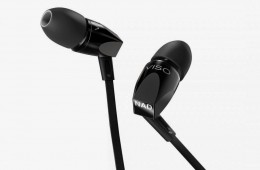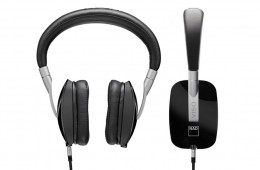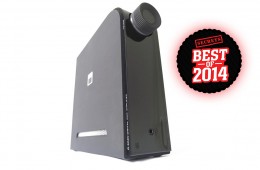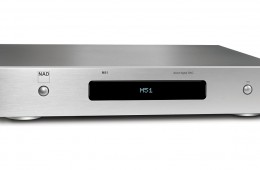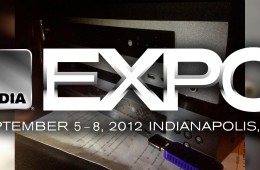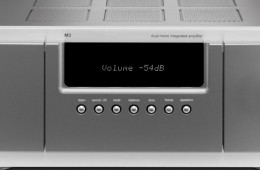NAD
NAD HP20 In-Ear Headphones (Earbuds)
The HP20 is a welcome addition to the in-ear (earbud) headphone family from none other than NAD. These little guys pack a lot of punch into a small package and at $169 they cost almost half as much as the $299 NAD HP50 headphones. Like the HP50, the HP20 also takes advantage of the years of research spent at the acoustic labs of Canada's National Research Council. This research is what Paul Barton utilized to create RoomFeel, the concept of making a headphone sound more like listening to a pair of speakers in a room.
NAD HP50 Viso Over-the-Ear Headphones
The NAD HP50 is the latest headphone design from Paul Barton, founder of PSB, a sister company of NAD, and features a new trademarked concept called RoomFeel. RoomFeel attempts to recreate the sound of listening to high-end speakers in a room. Most listening rooms add a low frequency bump to the sound that is often not taken into account when designing headphones. A room gain compensation transfer function was developed to add a +3 dB per octave boost from 200Hz down to 50Hz in order to replicate the fuller, warmer sound of a room. Clearly a lot of time and engineering has gone into the development of these headphones, the only question is, did it pay off? Yes it most certainly did.
NAD D 3020 Hybrid Digital Stereo Amplifier
When I left home for college in 1984, I brought my stereo system along. It consisted of a Kenwood receiver, Technics turntable, and a pair of Fisher 3-way speakers. After discovering a few high-end stereo shops in Boston, and having my turntable set up properly; I started shopping for a better amp. My meager funding ruled out separates but the proprietor of a small hi-fi shop pointed me to that now-familiar brown box. I returned to my dorm room clutching a brand-new NAD 3020, for which I believe I paid around $220. My reward was the cleanest sound I'd ever heard, bar none. I used that amp all through college and probably for another 10 years after. Today, NAD has recreated this amazing product for the digital age. Where we once relied on vinyl and ferrous tape, now it's all about bits and bytes. The timeless philosophy of clean high-quality sound, versatile operation, and a low price has now given birth to the all-new D 3020 Hybrid Digital Amplifier.
NAD VISO 1 AP AirPlay Music System
NAD introduced its own iPod dock, the VISO, last year at CEDIA. As one would expect from this high-end company, little expense was spared in its design as it sought to bridge the iPod, and other digital music players, with quality amplification and speakers while keeping it all in a compact package. With the proliferation of AirPlay streaming, it made sense that the second generation product should include this super-convenient feature. Hence, we have the VISO 1 AP, the subject of today's review. Where last year's VISO required you to chain your iPod to the unit, the AP lets you keep your iPod in your pocket so you can control your music from anywhere within reach of your WiFi network.
NAD C 390DD Direct Digital Integrated Amplifier
NAD launched its first direct digital amplifier, the M2, almost three years ago. As we have come to expect in audio and technology generally, however, it is never long before the state of the art trickles down to more modestly-priced products.
NAD M51 Direct Digital DAC
Most audio component manufacturers have a DAC in their product lineup, and NAD is no exception. However, the NAD M51 is unusual in that it takes the incoming digital PCM bitstream and converts it directly to a PWM bitstream, which is then fed directly to the output. The idea has been around for about a decade, but the technology for implementing it was not fast enough in those early days. Now, with modern technology and techniques, NAD has produced what they call a "Direct Digital DAC", where the digital signal does not go through digital to analog conversion in the normal sense, but converted to PWM at 844 kHz sampling, with 35 bit word length. As you will see with the bench tests, the results are quite amazing, and the price is very affordable.
CEDIA 2012 Show Report
SECRETS Cedia Team Show Report Wrap-up.....in the CAVE. Don't miss the OPPO prototypes for the new BDP-103 and BDP-105 shared with the SECRETS Team.
NAD M3 Integrated Stereo Amplifier
If you look at the specs of most stereo integrated amplifiers, the rated RMS power output is between 60 watts and 120 watts per channel. This is lower than the power output of outboard power amplifiers, which typically are about 125 watts to 300 watts per channel. Monoblocks go all the way up to 2,000 watts output. One of the main reasons for this is that in an integrated power amplifier, the preamplifier circuit is situated very close to the power amplifier. Keeping the high voltage, high current power amplifier signal from inducting noise into the preamplifier circuit is difficult. NAD apparently has solved this problem with the introduction of their M3 Integrated Amplifier, which has a rated output of 180 watts per channel, at 0.004% THD+N, and clipping (1% THD+N) at 220 watts.



